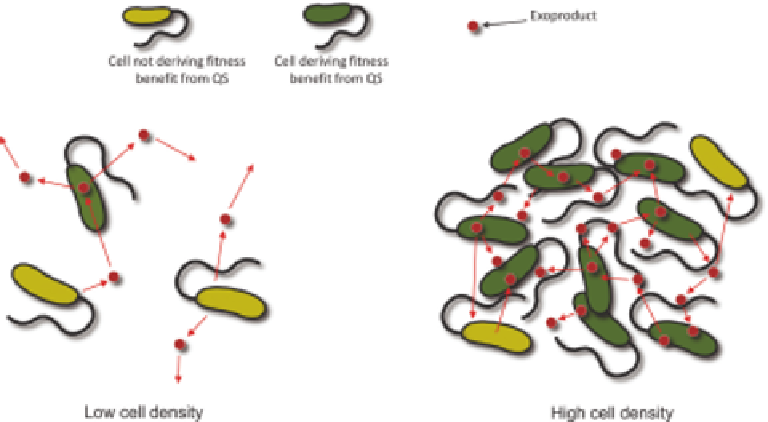Biology Reference
In-Depth Information
Fig. 14.15
The hypothesized function of quorum sensing. At low cell densities, a large
proportion of the extracellular factors (common goods or exoenzymes) disperse before
they can be used, so their production provides little fitness benefit. At high cell densities,
a much greater proportion of the extracellular common goods (or the products they
produce) can be used. Consequently, the production of extracellular common goods is
more efficient and beneficial at higher population densities.
that avoided the cost of responding to signals, or even by cells that signalled at a greater
rate to make other cells produce more exoproducts. What prevents cells from doing this,
and hence keeps them signalling honestly? Sam Brown and Rufus Johnstone (2001)
developed a theoretical model, which showed that quorum sensing could be
evolutionarily stable but that this required cells having a common interest due to being
related. When cells are growing alongside close relatives, kin selection provides a shared
interest in signalling to coordinate their behaviours in order to help each other.
Steve Diggle and colleagues tested this experimentally with the bacterium
Pseudomonas aeruginosa
. They exploited the fact that by working with bacteria you can
do things which just are not possible with animals such as peacocks or deer, such as
make genetic mutants and follow selection in multigeneration experiments. Diggle
et al
.
(2007) knocked out genes in the signalling pathway to create two genetic mutants, one
that did not produce signal (signal negative) and one that did not respond to signal
(signal blind). They first used these mutants to test whether signalling occurred
between cells. This was necessary because it is plausible that all or most of the signal
and benefits from exoproducts just flow back to the cell that produced them, in which
case quorum sensing would not be between-cell signalling. To resolve this question,
they grew normal quorum sensing (wild type) cells and mutants, either alone
(monoculture) or in mixtures. When grown in monoculture, the wild type grew to
larger densities than either of the mutants because it allowed the production of
Quorum sensing
requires that we
can explain both
honest signalling
and the
cooperative
production of
exoproducts …
… which can be
done by kin
selection if cells
are related































